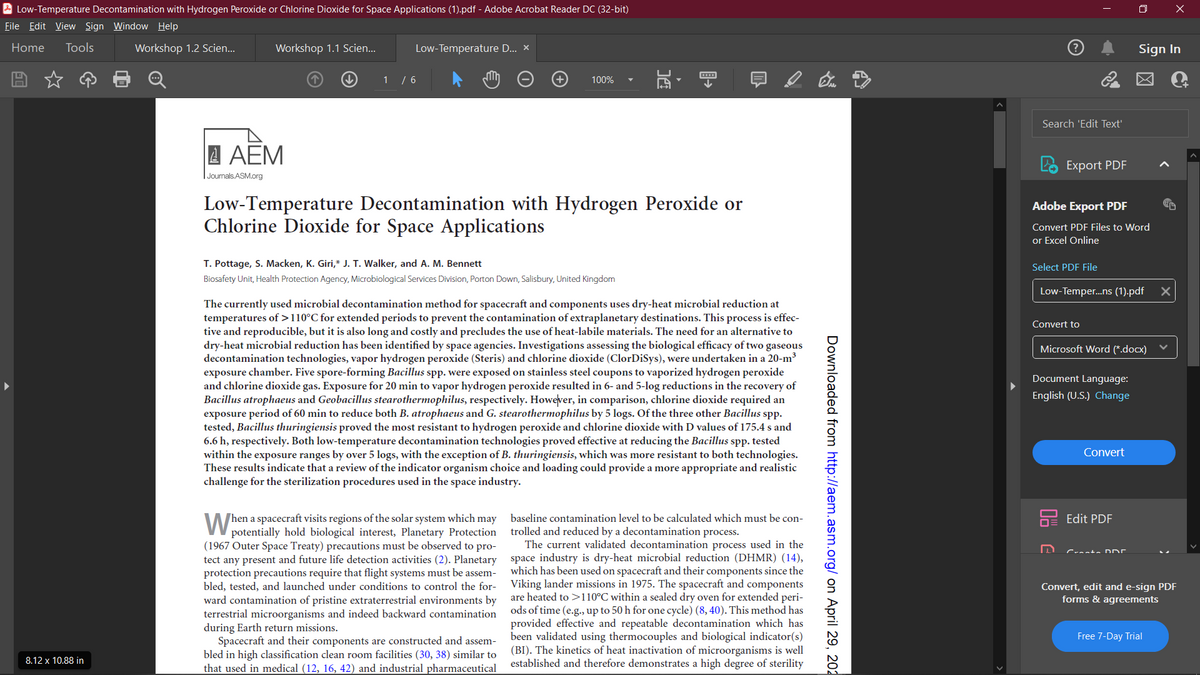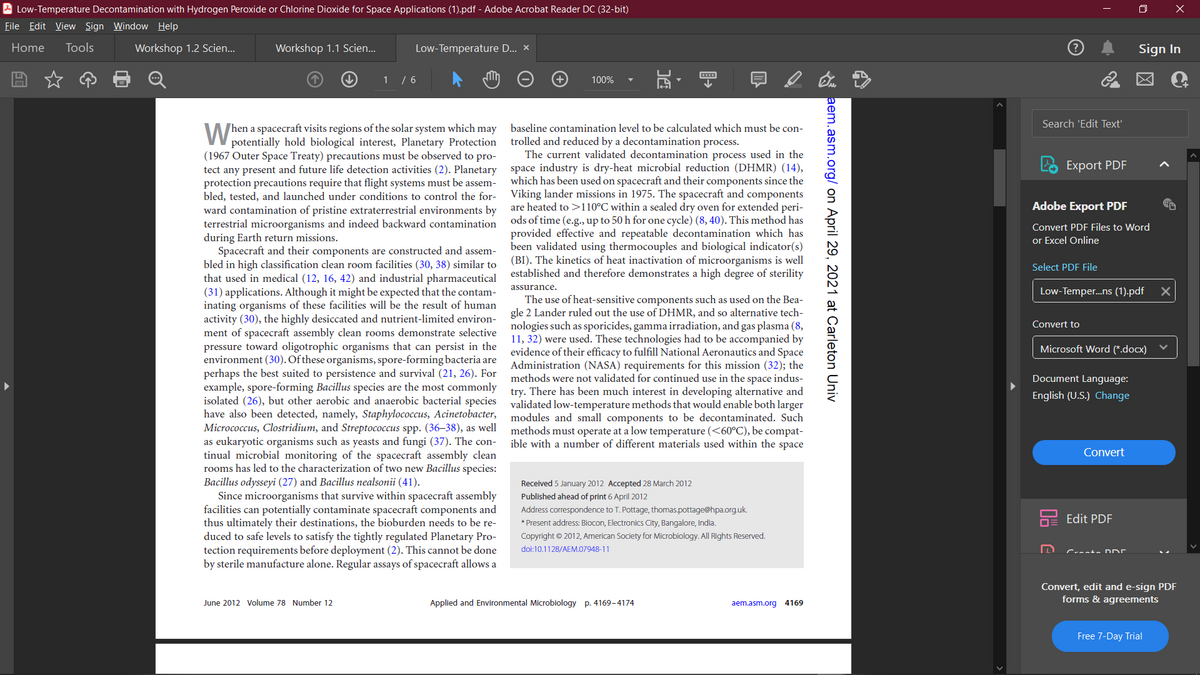4 AEM Joumals ASMorg Low-Temperature Decontamination with Hydrogen Peroxide or Chlorine Dioxide for Space Applications T. Pottage, S. Macken, K. Giri," J. T. Walker, and A. M. Bennett Biosafety Unit, Health Protection Agency, Microbiological Services Division, Porton Down, Salisbury, United Kingdom The currently used microbial decontamination method for spacecraft and components uses dry-heat microbial reduction at
4 AEM Joumals ASMorg Low-Temperature Decontamination with Hydrogen Peroxide or Chlorine Dioxide for Space Applications T. Pottage, S. Macken, K. Giri," J. T. Walker, and A. M. Bennett Biosafety Unit, Health Protection Agency, Microbiological Services Division, Porton Down, Salisbury, United Kingdom The currently used microbial decontamination method for spacecraft and components uses dry-heat microbial reduction at
Biomedical Instrumentation Systems
1st Edition
ISBN:9781133478294
Author:Chatterjee
Publisher:Chatterjee
Chapter20: Medical Safety
Section: Chapter Questions
Problem 2RT
Related questions
Question
Can you locate the scientific question in this article?

Transcribed Image Text:A Low-Temperature Decontamination with Hydrogen Peroxide or Chlorine Dioxide for Space Applications (1).pdf - Adobe Acrobat Reader DC (32-bit)
O X
File Edit View Sign Window Help
Home
Tools
Workshop 1.2 Scien..
Workshop 1.1 Scien.
Low-Temperature D... x
Sign In
1 / 6
100%
Search 'Edit Text'
I AĒM
Export PDF
Journals ASM.org
Low-Temperature Decontamination with Hydrogen Peroxide or
Chlorine Dioxide for Space Applications
Adobe Export PDF
Convert PDF Files to Word
or Excel Online
T. Pottage, S. Macken, K. Giri,* J. T. Walker, and A. M. Bennett
Select PDF File
Biosafety Unit, Health Protection Agency, Microbiological Services Division, Porton Down, Salisbury, United Kingdom
Low-Temper.ns (1).pdf
The currently used microbial decontamination method for spacecraft and components uses dry-heat microbial reduction at
temperatures of >110°C for extended periods to prevent the contamination of extraplanetary destinations. This process is effec-
tive and reproducible, but it is also long and costly and precludes the use of heat-labile materials. The need for an alternative to
dry-heat microbial reduction has been identified by space agencies. Investigations assessing the biological efficacy of two gaseous
decontamination technologies, vapor hydrogen peroxide (Steris) and chlorine dioxide (ClorDiSys), were undertaken in a 20-m3
exposure chamber. Five spore-forming Bacillus spp. were exposed on stainless steel coupons to vaporized hydrogen peroxide
and chlorine dioxide gas. Exposure for 20 min to vapor hydrogen peroxide resulted in 6- and 5-log reductions in the recovery of
Bacillus atrophaeus and Geobacillus stearothermophilus, respectively. However, in comparison, chlorine dioxide required an
exposure period of 60 min to reduce both B. atrophaeus and G. stearothermophilus by 5 logs. Of the three other Bacillus spp.
tested, Bacillus thuringiensis proved the most resistant to hydrogen peroxide and chlorine dioxide with D values of 175.4 s and
6.6 h, respectively. Both low-temperature decontamination technologies proved effective at reducing the Bacillus spp. tested
within the exposure ranges by over 5 logs, with the exception of B. thuringiensis, which was more resistant to both technologies.
These results indicate that a review of the indicator organism choice and loading could provide a more appropriate and realistic
challenge for the sterilization procedures used in the space industry.
Convert to
Microsoft Word (*.docx)
Document Language:
English (U.S.) Change
Convert
W;
|hen a spacecraft visits regions of the solar system which may
potentially hold biological interest, Planetary Protection
(1967 Outer Space Treaty) precautions must be observed to pro-
tect any present and future life detection activities (2). Planetary
protection precautions require that flight systems must be assem-
baseline contamination level to be calculated which must be con-
Edit PDF
trolled and reduced by a decontamination process.
rocess used in the
space industry is dry-heat microbial reduction (DHMR) (14),
which has been used on spacecraft and their components since the
bled, tested, and launched under conditions to control the for- Viking lander missions in 1975. The spacecraft and components
are heated to >110°C within a sealed dry oven for extended peri-
ods of time (e.g., up to 50 h for one cycle) (8, 40). This method has
provided effective and repeatable decontamination which has
been validated using thermocouples and biological indicator(s)
(BI). The kinetics of heat inactivation of microorganisms is well
established and therefore demonstrates a high degree of sterility
The current validated decontamination
Convert, edit and e-sign PDF
forms & agreements
ward contamination of pristine extraterrestrial environments by
terrestrial microorganisms and indeed backward contamination
during Earth return missions.
Spacecraft and their components are constructed and assem-
bled in high classification clean room facilities (30, 38) similar to
Free 7-Day Trial
8.12 x 10.88 in
that used in medical (12, 16, 42) and industrial pharmaceutical
Downloaded from http://aem.asm.org/ on April 29, 202

Transcribed Image Text:A Low-Temperature Decontamination with Hydrogen Peroxide or Chlorine Dioxide for Space Applications (1).pdf - Adobe Acrobat Reader DC (32-bit)
O X
File Edit View Sign Window Help
Home
Tools
Workshop 1.2 Scien..
Workshop 1.1 Scien.
Low-Temperature D... x
Sign In
1 / 6
100%
Search 'Edit Text'
W
|hen a spacecraft visits regions of the solar system which may
potentially hold biological interest, Planetary Protection
(1967 Outer Space Treaty) precautions must be observed to pro-
tect any present and future life detection activities (2). Planetary
protection precautions require that flight systems must be assem-
bled, tested, and launched under conditions to control the for-
baseline contamination level to be calculated which must be con-
trolled and reduced by a decontamination process.
The current validated decontamination process used in the
space industry is dry-heat microbial reduction (DHMR) (14),
which has been used on spacecraft and their components since the
Viking lander missions in 1975. The spacecraft and components
are heated to >110°C within a sealed dry oven for extended peri-
ods of time (e.g., up to 50 h for one cycle) (8, 40). This method has
provided effective and repeatable decontamination which has
been validated using thermocouples and biological indicator(s)
(BI). The kinetics of heat inactivation of microorganisms is well
established and therefore demonstrates a high degree of sterility
LO Export PDF
Adobe Export PDF
ward contamination of pristine extraterrestrial environments by
terrestrial microorganisms and indeed backward contamination
during Earth return missions.
Spacecraft and their components are constructed and assem-
bled in high classification clean room facilities (30, 38) similar to
that used in medical (12, 16, 42) and industrial pharmaceutical
(31) applications. Although it might be expected that the contam-
inating organisms of these facilities will be the result of human
activity (30), the highly desiccated and nutrient-limited environ-
ment of spacecraft assembly clean rooms demonstrate selective
pressure toward oligotrophic organisms that can persist in the
environment (30). Of these organisms, spore-forming bacteria are
perhaps the best suited to persistence and survival (21, 26). For
example, spore-forming Bacillus species are the most commonly
isolated (26), but other aerobic and anaerobic bacterial species validated low-temperature methods that would enable both larger
have also been detected, namely, Staphylococcus, Acinetobacter,
Micrococcus, Clostridium, and Streptococcus spp. (36–38), as well
as eukaryotic organisms such as yeasts and fungi (37). The con-
tinual microbial monitoring of the spacecraft assembly clean
rooms has led to the characterization of two new Bacillus species:
Bacillus odysseyi (27) and Bacillus nealsonii (41).
Since microorganisms that survive within spacecraft assembly
facilities can potentially contaminate spacecraft components and
thus ultimately their destinations, the bioburden needs to be re-
duced to safe levels to satisfy the tightly regulated Planetary Pro-
tection requirements before deployment (2). This cannot be done
by sterile manufacture alone. Regular assays of spacecraft allows a
Convert PDF Files to Word
or Excel Online
Select PDF File
assurance.
Low-Temper.ns (1).pdf
The use of heat-sensitive components such as used on the Bea-
gle 2 Lander ruled out the use of DHMR, and so alternative tech-
nologies such as sporicides, gamma irradiation, and gas plasma (8,
11, 32) were used. These technologies had to be accompanied by
evidence of their efficacy to fulfill National Aeronautics and Space
Administration (NASA) requirements for this mission (32); the
methods were not validated for continued use in the space indus-
try. There has been much interest in developing alternative and
Convert to
Microsoft Word (*.docx)
Document Language:
English (U.S.) Change
modules and small components to be decontaminated. Such
methods must operate at a low temperature (<60°C), be compat-
ible with a number of different materials used within the space
Convert
Received 5 January 2012 Accepted 28 March 2012
Published ahead of print 6 April 2012
Address correspondence to T. Pottage, thomas.pottage@hpa.org.uk.
Edit PDF
* Present address: Biocon, Electronics City, Bangalore, India.
Copyright © 2012, American Society for Microbiology. All Rights Reserved.
doi:10.1128/AEM.07948-11
Convert, edit and e-sign PDF
forms & agreements
June 2012 Volume 78 Number 12
Applied and Environmental Microbiology p. 4169-4174
aem.asm.org 4169
Free 7-Day Trial
* aem.asm.org/ on April 29, 2021 at Carleton Univ
Expert Solution
This question has been solved!
Explore an expertly crafted, step-by-step solution for a thorough understanding of key concepts.
Step by step
Solved in 2 steps

Recommended textbooks for you



Understanding Health Insurance: A Guide to Billin…
Health & Nutrition
ISBN:
9781337679480
Author:
GREEN
Publisher:
Cengage



Understanding Health Insurance: A Guide to Billin…
Health & Nutrition
ISBN:
9781337679480
Author:
GREEN
Publisher:
Cengage

Case Studies In Health Information Management
Biology
ISBN:
9781337676908
Author:
SCHNERING
Publisher:
Cengage